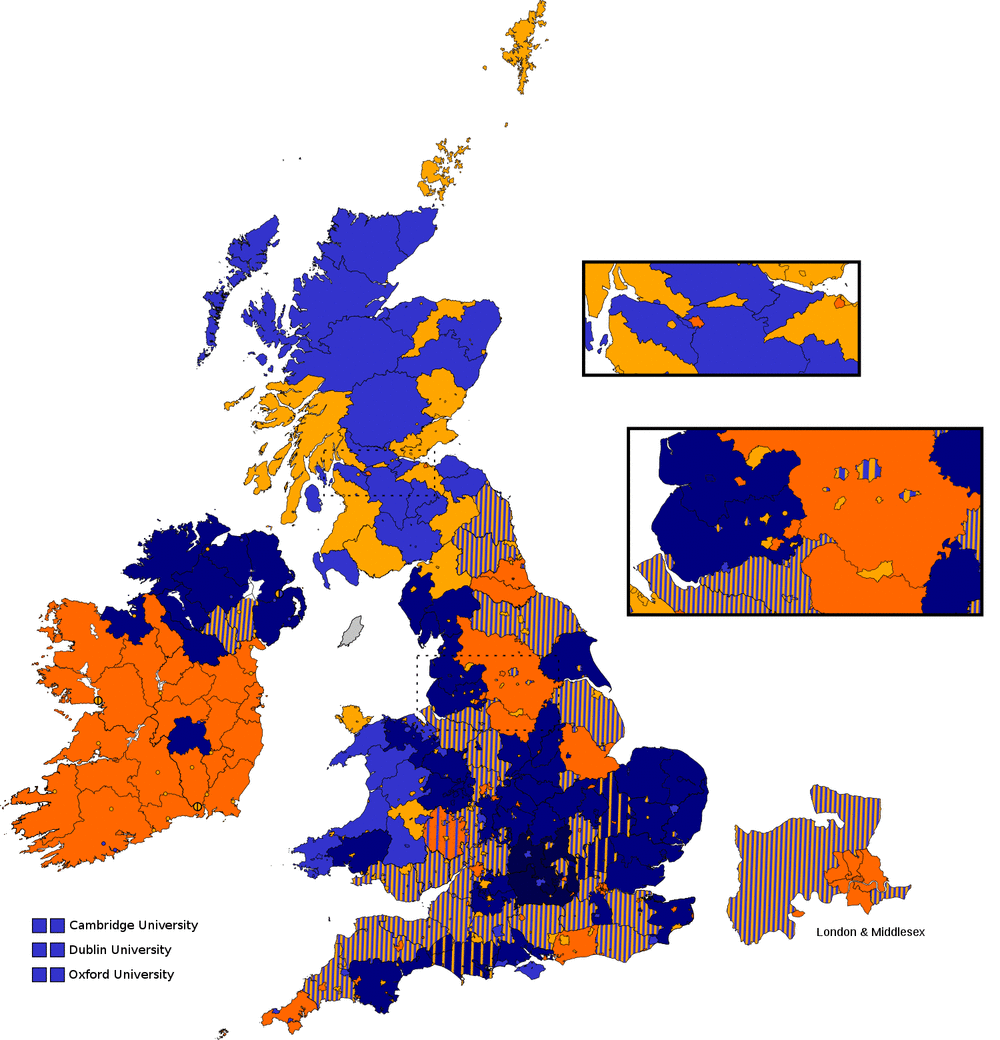| North Derbyshire |
|---|
Former County constituency
for the House of Commons |
Form 1832-1868. Extract from 1837 result: the westerly 'doubly' orange area. |
| 1832–1885 |
|---|
| Number of members | two |
|---|
| Replaced by | High Peak and West Derbyshire |
|---|
| Created from | Derbyshire |
|---|
North Derbyshire was a Parliamentary constituency in the United Kingdom constituencies. It originally returned two Knights of the Shire to the House of Commons of the Parliament of the United Kingdom.
The constituency was created when Derbyshire constituency was split into North Derbyshire and South Derbyshire under the 1832 Reform Act. It was abolished in 1885, together with the constituencies of South Derbyshire and East Derbyshire. In 1885 the area of the three constituencies was split between the new smaller constituencies of Chesterfield, Mid Derbyshire, North-East Derbyshire, South Derbyshire, West Derbyshire, High Peak and Ilkeston.
Boundaries
1832–1868: The Hundreds of High Peak and Scarsdale, and so much of the Wapentake of Wirksworth as was comprised in the Bakewell Division.[1]
1868–1885: The Hundred of High Peak and the Wapentake of Wirksworth.[2]
Members of Parliament

John Cheetham
Election results
Elections in the 1830s
General election 1832: North Derbyshire[9][3] | Party | Candidate | Votes | % |
| | Whig | William Cavendish | 3,388 | 48.7 |
| | Whig | Thomas Gisborne | 2,385 | 34.3 |
| | Tory | Sir George Sitwell, 2nd Baronet | 1,183 | 17.0 |
| Majority | 1,202 | 17.3 |
| Turnout | 3,677 | 84.1 |
| Registered electors | 4,370 | |
| | Whig win (new seat) |
| | Whig win (new seat) |
Cavendish succeeded to the peerage, becoming 7th Duke of Devonshire and causing a by-election.
By-election, 27 May 1834: North Derbyshire[9][3] | Party | Candidate | Votes | % |
| | Whig | George Cavendish | Unopposed |
| Registered electors | 4,370 | |
| | Whig hold |
General election 1835: North Derbyshire[9][3] | Party | Candidate | Votes | % |
| | Whig | George Cavendish | Unopposed |
| | Whig | Thomas Gisborne | Unopposed |
| Registered electors | 4,175 | |
| | Whig hold |
| | Whig hold |
General election 1837: North Derbyshire[9][3] | Party | Candidate | Votes | % |
| | Whig | George Cavendish | 2,816 | 39.0 |
| | Whig | William Evans | 2,422 | 33.5 |
| | Conservative | George Arkwright | 1,983 | 27.5 |
| Majority | 439 | 6.0 |
| Turnout | 4,481 | 81.1 |
| Registered electors | 5,527 | |
| | Whig hold |
| | Whig hold |
Elections in the 1840s
General election 1841: North Derbyshire[9] | Party | Candidate | Votes | % | |
| | Whig | George Cavendish | Unopposed |
| | Whig | William Evans | Unopposed |
| Registered electors | 5,757 | | |
| | Whig hold |
| | Whig hold |
General election 1847: North Derbyshire[9] | Party | Candidate | Votes | % | |
| | Whig | George Cavendish | Unopposed |
| | Whig | William Evans | Unopposed |
| Registered electors | 5,601 | | |
| | Whig hold |
| | Whig hold |
Elections in the 1850s
General election 1852: North Derbyshire[9] | Party | Candidate | Votes | % | |
| | Whig | George Cavendish | Unopposed |
| | Whig | William Evans | Unopposed |
| Registered electors | 5,315 | | |
| | Whig hold |
| | Whig hold |
Evans resigned, causing a by-election.
By-election, 22 July 1853: North Derbyshire[9] | Party | Candidate | Votes | % | |
| | Independent Liberal | William Pole Thornhill | 1,680 | 58.4 | New |
| | Whig | William Evans[10][11] | 1,195 | 41.6 | N/A |
| Majority | 485 | 16.8 | N/A |
| Turnout | 2,875 | 55.1 | N/A |
| Registered electors | 5,219 | | |
| | Independent Liberal gain from Whig | Swing | N/A | |
Evans resigned before the poll concluded.[12]
General election 1857: North Derbyshire[9] | Party | Candidate | Votes | % | |
| | Whig | George Cavendish | Unopposed |
| | Independent Liberal | William Pole Thornhill | Unopposed |
| Registered electors | 5,336 | | |
| | Whig hold |
| | Independent Liberal gain from Whig |
Elections in the 1860s
Elections in the 1870s
Elections in the 1880s
See also
References

